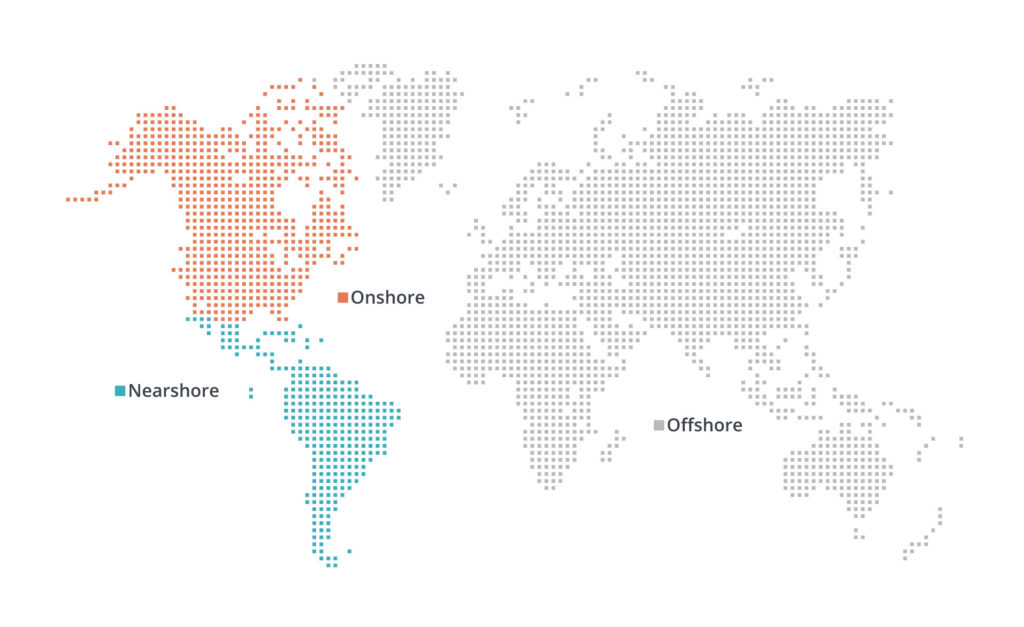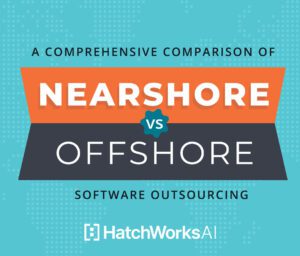Every once and a while a trend emerges which transforms the world. It can be as simple as the introduction of jeans as a wardrobe staple to the dramatic automation of machines in the Industrial Revolution.
In recent years, nearshoring has fallen somewhere in between with the US taking advantage of nearshore services, especially in the tech space.

But what is it? Why is it so popular? And what’s its future look like?
We go into all of that below, looking through the lens of Nearshore Software Development.
What is Nearshoring? A Definition and Background
Nearshoring is an outsourcing model where businesses use companies in neighboring countries to complete work they can’t or don’t want to do in-house (due to lack of time, resources, or expertise).
It’s a cost effective alternative to using onshore freelancers and agencies and a practical alternative to offshore teams because a team or individual in a nearby country is able to work in the same or similar timezone.
| Nearshore | Offshore | Onshore |
|---|---|---|
|
Outsourcing to neighboring countries with similar time zones.
|
Outsourcing to distant countries with significant time zone differences.
|
Outsourcing within the same country.
|
|
Often cost-effective and allows for easy collaboration.
|
Often cost-effective but can present difficulties in communication.
|
Often costly but avoids cultural differences and language barriers.
|
|
Central and South America
|
Africa, Europe, and Asia
|
United States and Canada
|

For US-based companies, their nearshore options are Canada or Latin America (LatAm) but it’s the latter which offers the biggest cost benefit.
Nearshoring isn’t a new concept but it has increased in popularity in recent years. In a 2022 article, Bloomberg reports 80% of companies in North America are actively considering nearshoring.
Popular Nearshore Locations for US-Based Businesses
Latin America offers a variety of nearshore locations for U.S. businesses. The region as a whole is rising in the tech world, but some countries have become favorites for nearshore outsourcing due to their robust tech infrastructure and talent pool. Here’s a quick look at some top nearshore locations:- Costa Rica: With its emphasis on education and a stable political scene, Costa Rica is renowned for high-quality software development. It’s a smaller market, but its specialized tech talent is a major draw.
- Colombia: Growing as a tech leader, Colombia’s IT sector is booming. Cities like Bogotá and Medellín are becoming hotspots for tech innovation, drawing in businesses for nearshore collaborations.
- Brazil: Brazil’s mature tech industry offers a comprehensive range of services from software development to advanced data analytics. Its sizable talent pool makes it a go-to for robust IT solutions.
- Argentina: Celebrated for its high-caliber tech education, Argentina produces creative and innovative tech professionals. Buenos Aires, in particular, is a magnet for tech activity.
- Mexico: With key tech hubs like Guadalajara, Mexico combines technical expertise with cultural proximity to the U.S. This makes for easy collaboration and has positioned Mexico as a favored nearshore choice.
The Rise of Nearshore Software Development
Within the broader trend toward nearshore, the tech industry is leading the charge with Nearshore Software Development.
This trend is fueled by the inherent need for collaboration and constant communication in software projects between internal teams and external partners.
And it’s been made possible by the growth of the tech industry in Latin America.
Don’t believe us? IDL Labs projects Latin American, and Caribbean tech startups are set to reach $2 trillion in value by 2030 and this is after their industry has grown from an estimated $7 billion in 2010 to $221 billion in 2020.
And it’s reported software developers from Latin America are among the top-rated globally. Businesses in the US can now use them to build quality software at a fraction of the cost it would cost to hire an onshore team.
Why Businesses Choose Nearshoring: Key Advantages
In the past, offshore has been the outsourcing model of choice. But over time, cracks in the model have revealed themselves.
Offshoring can bring with it:
- language barriers
- opposing work cultures
- difficulties in collaboration due to time zone differences,
- and unreliable English proficiency.
And it’s those areas where nearshore shines.
US-based companies seek nearshore talent in Latin America because of a close workday overlap, strong cultural fit, and high English language proficiency.
Source: Accelerance
Below we’ve outlined the top 4 advantages of nearshoring in more detail:
It’s cost effective and convenient
According to Deloitte, 59% of companies choose nearshoring for its cost benefits.
This isn’t surprising given nearshoring is more economical than hiring locally (either in-house tech talent or outsourcing to an onshore boutique agency).
In fact, the average cost of hiring a developer in the US is $159,932. That figure includes resources spent recruiting talent in addition to the salary but doesn’t include benefits or other costs.
And compared to offshoring, nearshoring is just as cost-effective while being more conveniently located.
So it’s no wonder American based businesses are turning to LatAm options.
There are fewer cultural differences
For US companies, working with teams in Latin America is like working with your neighbor. There’s an unspoken commonality between us from the Netflix shows we watch to a history of colonization by European powers.
From these shared roots and interests comes an understanding that smooths out collaboration between in-house teams and outsourced ones.
Plus, the widespread English fluency in Latin America means communication is clear and straightforward, making projects run more smoothly.
Latin America offers access to top talent
We previously mentioned that tech talent in LatAm is among the top rated globally.
When you opt for nearshoring outsourcing, you open the door to this pool of talent.
These experts bring new ideas and advanced skills to the table, enhancing the quality of your projects significantly.
Many US software teams will use staff augmentation to increase capabilities and integrate an outsourced partner into their business operations.
Nearshoring is scalable and flexible
One of the most attractive features of nearshoring is its scalability, especially for businesses looking to adapt and grow in a competitive market.
Nearshoring lets you scale your team up or down as needed. Have a big project that requires expertise you don’t have or simply needs more hands behind it? Nearshoring can easily meet those needs. Want to scale back once it’s done? No problem.
That’s not something you can do with an in-house team.
And thanks to Nearshore’s proximity, scaling up doesn’t mean losing control or oversight. You can keep a close eye on your project’s progress, ensuring quality isn’t sacrificed for speed.
Challenges and Considerations in Nearshoring
Nearshoring offers many benefits, but it’s not without its challenges.
One of the main concerns is geopolitical risk. Countries may experience unrest or economic upheaval, potentially disrupting projects.
HatchWorks, as a Nearshore Software Development partner addresses this by having a U.S.-based headquarters and utilizing developers from various Latin American countries. This diversity ensures that if one country faces issues, your project can continue smoothly with minimal interruptions, thanks to the support from other regions.
Another hurdle can be language barriers. While many Latin American software developers are proficient in English, it’s often their second language. This might lead to occasional misunderstandings or communication gaps.
Again, HatchWork’s US presence reduces this risk because you’ll have a local team managing the process, selecting the right developers, and ensuring it all goes smoothly.
Finally, security risks, including data breaches or intellectual property theft, are critical concerns in any outsourcing model.
Strategies to Overcome These Challenges
To tackle these challenges, here are some strategies for an effective outsourcing strategy:
- Diversify Talent Sources: Similar to HatchWorks’ model, diversifying the countries you source talent from can mitigate risks associated with reliance on a single region.
- Invest in Language and Cultural Training: Encourage cross-cultural training and language proficiency courses to bridge any communication gaps.
- Stay Informed on Regulations: Keep up-to-date with the legal and regulatory environments of the countries you’re working with. This knowledge can help navigate and comply with local requirements and keep your data secure.
- Build Strong Local Partnerships: Establish strong relationships with local partners like HatchWorks who understand the regional nuances and can offer valuable insights and support.
📕 Further reading: Proven Strategies for Mitigating Nearshore Software Development Risks
The Future of Nearshoring
Outsourcing solutions have traditionally shifted manual work that required little expertise. But nearshoring is continually tapping into the knowledge of our next door neighbors.
Businesses are recognizing the intellectual capacity within nearshore regions. This means a growing demand for specialized skills and higher education levels in these markets. Nearshore professionals won’t just be executing tasks; they’ll be contributing essential expertise and innovative solutions.
The nature of nearshoring relationships is also shifting.
We’re moving away from transactional outsourcing to more integrated, partnership-based collaborations. This new approach focuses on long-term value creation and mutual growth. It’s about building relationships that are not just beneficial but also responsible, adhering to global corporate responsibility standards.
Our unique approach to fusing US expertise and Latin American scalability and affordability is what sets us apart—and it’s proving to be a winning formula.
Brandon Powell, CEO of HatchWorks
The Impact of AI on Nearshore Software Development
AI has rapidly developed in 2023 and it will continue to do so for the foreseeable future.
Here’s how AI is impacting Nearshore Software Development:
- Automated Development: AI can take on or assist in software development tasks. This means nearshore teams can deliver more, faster. It’s like turbocharging the development process, making ‘build’ strategies more efficient.
- Innovation at the Forefront: AI’s ability to generate creative solutions opens new doors for innovation in nearshoring. Teams can explore unique features and functionalities, pushing the boundaries of what’s possible.
- Continuous Improvement: AI doesn’t just build; it learns and improves. This means software developed via nearshoring can continually evolve, staying ahead of the curve.
But it’s not all smooth sailing. AI, especially tools like ChatGPT, can have limitations, like inaccurate data generation.
Ethical and security considerations are also crucial. As Matt Paige, VP of Marketing and Strategy at HatchWorks, points out, the decision between using off-the-shelf AI solutions and building proprietary ones involves weighing privacy and data security risks.
If you’re looking into nearshoring something other than software development, then the impact is still the same, it just will be applied to different business processes.
How Businesses Can Prepare for These Changes
To adapt to these changes, businesses should focus on building strong, collaborative relationships with nearshore partners.
They should also invest in training and technology to harness the full potential of AI and other emerging tech trends. By doing so, companies can ensure they are well-positioned to leverage the evolving landscape of nearshoring.
Reap the Rewards of Nearshore Software Development with HatchWorks
At HatchWorks, we blend high-touch, local service with the affordability and efficiency of nearshore outsourcing. Our teams, boasting a 98.5% retention rate and fluent English skills, ensure your projects run without interruptions or delays.
We’re a trusted nearshore partner for businesses that need quality software development and a solution that scales as they do.
Check out past projects we’ve worked on and the outcomes those businesses have gone on to achieve here.
→ If you want to see how nearshoring can expedite your development at a fraction of the cost, contact HatchWorks today. ←
We’re ready to support your project!
Instantly access the power of AI with our AI Engineering Teams.




